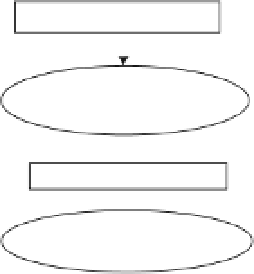Geography Reference
In-Depth Information
) defines the efficiency of amaterial at radi-
ating energy compared to a blackbody. Emissivity values
range from0 to 1. A
blackbody
is a theoreticalmaterial with
an emissivity of 1, which absorbs all incident radiation
and re-emits it perfectly at all wavelengths. A
graybody
has an emissivity that is independent of wavelength
Emissivity (
ε
Spectral radiance at sensor
(Wm
-2
sr
-1
m
-1
)
μ
Multiple
possible
sources
L
p
,
τ
Atmospheric correction
λ
and is
<
1. A
selective radiator
will have an emissivity
that varies across wavelengths, and this characteristic can
be used to identify the material based on its emissivity
spectra. In the natural environment true blackbodies do
not exist, which means that T
r
will always be less than T
k
.
Water can approximate a blackbody as its emissivity
in the 8-14
Spectral radiance at surface
(Wm
-2
sr
-1
m
-1
)
μ
ε
Emissivity correction
Corrected spectral radiance
(Wm
-2
sr
-1
μ
m
-1
)
m range is near 1 (Figure 5.6). There are
many factors which influence water's actual emissivity.
The emissivity of water can vary with the amount of
suspended sediment (Salisbury and Aria, 1992), and dis-
solved minerals (e.g., as found in sea water). Features
such as riffles and surface foam, which can roughen the
water surface, will also alter the emissivity, as can physi-
cal characteristics such as wet rocks that have a different
emissivity (closer to water) than dry rocks. As well as vary-
ing with wavelength, emissivity varies with the compound
effects of both angular effects and the surface roughness.
For large observation angles (
μ
Calculate temperature using Planck's Law
Radiant temperature
at surface (
°
C)
Figure 5.5
Flowchart summarizing the suggested processing of
TIR data to determine stream temperature. See the Table of
Abbreviations and text for definitions.
70
◦
from nadir), rough
water will have a higher emissivity than placid water at the
same observation angle and will therefore appear warmer
(Masuda et al., 1988). When the roughness of the water
surface is constant, for small observation angles up to 30
◦
there is a small decrease in spectrally variable emissiv-
ity and temperature (e.g.,
>
and emitted from water vapour, TIR applications focus
on the 8-14
m region of the electromagnetic spectrum
where atmospheric interference and contamination by
solar radiation (in the 3-5
μ
μ
m region) is minimised.
1
◦
Cat10
<
0
.
μ
m for distilled
5.3.2 The relationshipbetweenemissivity
andkineticandradiant temperature
70
◦
Fresnel
reflection increases and the emissivity and T
r
are signif-
icantly lower (Masuda et al., 1988; Ishiyama et al., 1995;
Cuenca and Sobrino, 2004). In practical terms, providing
the observation angles are within
2
◦
C), but for observation angles
water at 17
.
>
A material's T
k
is determined by the particular thermal
characteristics of the material and its heat budget. In
simplistic terms, this heat budget results from energy
being absorbed, transmitted, and reflected, sometimes
multiple times. For example, water has a high
thermal
inertia
, which means that it changes temperature slowly
as heat energy is added, a low
thermal conductivity
,which
means that heat passes through it slowly, and a high
thermal capacity
, which means that it stores heat well.
Whereas the T
k
of water can be measured directly
using a thermometer that is in contact or immersed in
the water, TIR remote sensing of water (using a radiant
thermometer, or a ground-, air-, or space-borne imaging
sensor) relies instead on indirect measurements of the
radiation, emitted by the water body, to determine the
water's radiant temperature, T
r
. The amount and spectral
distribution of this radiated energy is a combination of
the material's T
k
and its surface emissivity.
30
◦
of nadir these
∼
effects are negligible.
The emissivity should therefore be chosen to match
the specific water characteristics, and care taken in inter-
pretation of TIR data under conditions which might
change the emissivity. As the emissivity varies with wave-
length, the emissivity should be matched to the band
wavelength specifications of the sensor, and care should
be taken when narrow-band temperatures are compared
to temperatures obtained from sensors with different
band characteristics.
The reflectivity of a material is the proportion of radi-
ation incident upon it that is reflected back. There are a
number of laws describing how energy is absorbed, trans-
mitted and reflected, and for brevity we will only detail
here with what is needed for applied TIR remote sensing













Search WWH ::

Custom Search